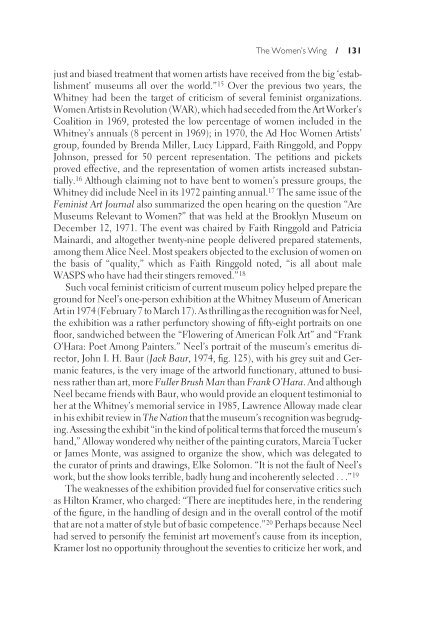i-xxii Front matter.qxd - Brandeis Institutional Repository
i-xxii Front matter.qxd - Brandeis Institutional Repository
i-xxii Front matter.qxd - Brandeis Institutional Repository
Create successful ePaper yourself
Turn your PDF publications into a flip-book with our unique Google optimized e-Paper software.
The Women’s Wing / 131just and biased treatment that women artists have received from the big ‘establishment’museums all over the world.” 15 Over the previous two years, theWhitney had been the target of criticism of several feminist organizations.Women Artists in Revolution (WAR), which had seceded from the Art Worker’sCoalition in 1969, protested the low percentage of women included in theWhitney’s annuals (8 percent in 1969); in 1970, the Ad Hoc Women Artists’group, founded by Brenda Miller, Lucy Lippard, Faith Ringgold, and PoppyJohnson, pressed for 50 percent representation. The petitions and picketsproved effective, and the representation of women artists increased substantially.16 Although claiming not to have bent to women’s pressure groups, theWhitney did include Neel in its 1972 painting annual. 17 The same issue of theFeminist Art Journal also summarized the open hearing on the question “AreMuseums Relevant to Women?” that was held at the Brooklyn Museum onDecember 12, 1971. The event was chaired by Faith Ringgold and PatriciaMainardi, and altogether twenty-nine people delivered prepared statements,among them Alice Neel. Most speakers objected to the exclusion of women onthe basis of “quality,” which as Faith Ringgold noted, “is all about maleWASPS who have had their stingers removed.” 18Such vocal feminist criticism of current museum policy helped prepare theground for Neel’s one-person exhibition at the Whitney Museum of AmericanArt in 1974 (February 7 to March 17). As thrilling as the recognition was for Neel,the exhibition was a rather perfunctory showing of ƒfty-eight portraits on one„oor, sandwiched between the “Flowering of American Folk Art” and “FrankO’Hara: Poet Among Painters.” Neel’s portrait of the museum’s emeritus director,John I. H. Baur (Jack Baur, 1974, ƒg. 125), with his grey suit and Germanicfeatures, is the very image of the artworld functionary, attuned to businessrather than art, more Fuller Brush Man than Frank O’Hara. And althoughNeel became friends with Baur, who would provide an eloquent testimonial toher at the Whitney’s memorial service in 1985, Lawrence Alloway made clearin his exhibit review in The Nation that the museum’s recognition was begrudging.Assessing the exhibit “in the kind of political terms that forced the museum’shand,” Alloway wondered why neither of the painting curators, Marcia Tuckeror James Monte, was assigned to organize the show, which was delegated tothe curator of prints and drawings, Elke Solomon. “It is not the fault of Neel’swork, but the show looks terrible, badly hung and incoherently selected...” 19The weaknesses of the exhibition provided fuel for conservative critics suchas Hilton Kramer, who charged: “There are ineptitudes here, in the renderingof the ƒgure, in the handling of design and in the overall control of the motifthat are not a <strong>matter</strong> of style but of basic competence.” 20 Perhaps because Neelhad served to personify the feminist art movement’s cause from its inception,Kramer lost no opportunity throughout the seventies to criticize her work, and
















